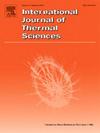多孔结构对开口微通道-鳍片组合式散热器热水力特性的影响
IF 4.9
2区 工程技术
Q1 ENGINEERING, MECHANICAL
International Journal of Thermal Sciences
Pub Date : 2025-04-14
DOI:10.1016/j.ijthermalsci.2025.109933
引用次数: 0
摘要
随着数据中心计算能力的快速发展,导致电子芯片发热量急剧增加。传统的散热器不能有效去除超高热流密度。为了应对严重的过温问题,确保电子芯片的安全运行,开发了新型多孔结构散热器。探讨了多孔结构的位置、孔隙度和渗透率对热学和水动力特性的影响,并与传统的光滑微通道(SM)和带固体针鳍的开放式微通道(OM-SPF)进行了比较。结果表明,多孔结构有利于增加换热面积,扩大流动空间。但其排列方式对温度控制能力和热输运速率有显著影响。对于带有多孔针片的开放微通道(OM-PPF),摩擦损失降低了57.1%,但微扰效应远弱于固体微通道。对于具有多孔侧壁肋的开放式微通道(OM-PSR),在Re = 631时,其Nusselt数比SM、OM-PPF和OM-SPF分别提高了2.7倍、2.2倍和1.6倍,峰值温度分别降低了9.5℃、5.6℃和2.5℃。在Re = 131时,OM-PSR的摩擦因数比OM-SPF小55.1%。在Re = 329时,OM-PSR的总性能指数(TPI)达到2.0,其中心固体翅片增强传热和多孔侧壁减阻的协同效应使其整体性能优越。多孔侧壁的孔隙度小、渗透率大,因而具有较高的努塞尔数、较低的摩擦系数和较好的综合效率。孔隙率为0.2,渗透率为1 × 10−8 m2的OM-PSR在Re = 131时TPI最高,为4.63,有利于平衡散热和泵耗,在提高大功率数据中心制冷系统能效方面具有很大潜力。本文章由计算机程序翻译,如有差异,请以英文原文为准。
Effect of porous structure on the thermal and hydraulic features of combined heat sinks with open microchannels and pin-fins
The rapid development of the computing power of data centers, has resulted in a sharp increase of heat generation on electronic chips. The traditional heat sinks cannot remove the ultra-high heat flux effectively. Novel heat sinks with porous structures are developed to cope with serious overtemperature issues to ensure the safe operation of electronic chips. The effect of the position, porosity, and permeability of porous configurations on the thermal and hydrodynamic features is explored and compared with the traditional smooth microchannel (SM) and the open microchannel with solid pin-fins (OM-SPF). Results manifest that the porous structure is conducive to increasing heat transfer area and enlarging flow space. However, its arrangement significantly influences the temperature control ability and thermal transport rate. For the open microchannel with porous pin-fins (OM-PPF), the friction loss is reduced by 57.1 %, but the perturbance effect is much weaker than the solid counterpart. For the open microchannel with porous sidewall ribs (OM-PSR), the Nusselt number is increased by 2.7, 2.2, and 1.6 times, the peak temperature is reduced by 9.5 °C, 5.6 °C, and 2.5 °C compared to the SM, OM-PPF, and OM-SPF at Re = 631. The friction factor of OM-PSR is 55.1 % smaller than the OM-SPF at Re = 131. The synergy effect of the heat transport enhancement by central solid fins and the drag reduction by porous sidewalls in OM-PSR brings a superior overall capability with a total performance index (TPI) of 2.0 at Re = 329. The small porosity and large permeability of porous sidewalls result in a higher Nusselt number, lower friction factor, and better overall efficiency. The OM-PSR with porosity of 0.2 and permeability of 1 × 10−8 m2 obtains the highest TPI of 4.63 at Re = 131, which helps to balance the heat dissipation and pump consumption, demonstrates a great potential for improving the energy efficiency of the cooling system in high-power data centers.
求助全文
通过发布文献求助,成功后即可免费获取论文全文。
去求助
来源期刊

International Journal of Thermal Sciences
工程技术-工程:机械
CiteScore
8.10
自引率
11.10%
发文量
531
审稿时长
55 days
期刊介绍:
The International Journal of Thermal Sciences is a journal devoted to the publication of fundamental studies on the physics of transfer processes in general, with an emphasis on thermal aspects and also applied research on various processes, energy systems and the environment. Articles are published in English and French, and are subject to peer review.
The fundamental subjects considered within the scope of the journal are:
* Heat and relevant mass transfer at all scales (nano, micro and macro) and in all types of material (heterogeneous, composites, biological,...) and fluid flow
* Forced, natural or mixed convection in reactive or non-reactive media
* Single or multi–phase fluid flow with or without phase change
* Near–and far–field radiative heat transfer
* Combined modes of heat transfer in complex systems (for example, plasmas, biological, geological,...)
* Multiscale modelling
The applied research topics include:
* Heat exchangers, heat pipes, cooling processes
* Transport phenomena taking place in industrial processes (chemical, food and agricultural, metallurgical, space and aeronautical, automobile industries)
* Nano–and micro–technology for energy, space, biosystems and devices
* Heat transport analysis in advanced systems
* Impact of energy–related processes on environment, and emerging energy systems
The study of thermophysical properties of materials and fluids, thermal measurement techniques, inverse methods, and the developments of experimental methods are within the scope of the International Journal of Thermal Sciences which also covers the modelling, and numerical methods applied to thermal transfer.
 求助内容:
求助内容: 应助结果提醒方式:
应助结果提醒方式:


